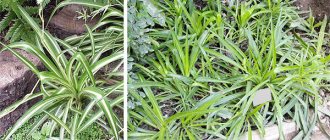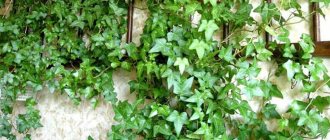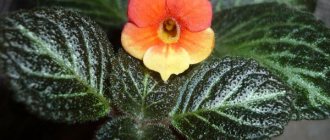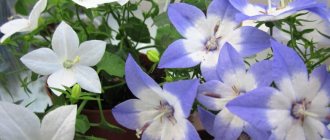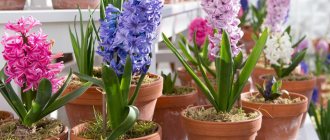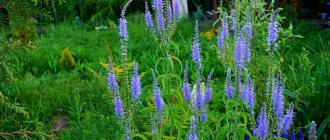Indoor flowers such as chlorophytum are called plants for lazy people. It can remain unattended by its owners for a long time, reproduces easily, rarely gets sick, and stands anywhere - in the back of the room or on the kitchen windowsill. The popularity of the culture is added by its attractive appearance, the ability to effectively purify the air, and the fact that caring for chlorophytum will not seem difficult even for a beginner. The only problem is that cats love the flower. If an animal gets to the plant, it will definitely chew off the leaves, and it will look sad.
Description and other names
Chlorophytum is a genus of herbaceous perennial plants that unites about 200 species. Previously it was included in the Liliaceae family, now it is classified as Asparagus. The homeland of chlorophytum is the humid subtropics of South Africa. Some species are common in Australia and southeast Asia.
Chlorophytum literally translates to “green plant.” The flower is often called spider lily, sedge, bridal lily, viviparous corolla, green lily.
Most species of chlorophytum in nature behave like epiphytes, growing on large branches of trees in the subtropical forest. They cling to the bark, receive water from precipitation, and nutrition from photosynthesis and air.
The root system of chlorophytum allows you to store a sufficient supply of moisture and plastic substances to survive an unfavorable period. Even in cultivation, with uneven watering, the fibrous shoots thicken, become translucent, juicy, and pearl-colored. And they grow overgrown with their own thin roots, extracting water and nutrition from the substrate.
They should not be confused with modified stems - tubers, bulbs, etc. In biology, such formations are called root cones, which are mistakenly compared by amateurs to potatoes. In fact, the underground part of the plant is similar to dahlias, buttercups, and clivias.
The leaves of Chlorophytum are succulent, soft or moderately hard, usually linear, lanceolate, sessile, rarely (Chlorophytum amaniense) - oval, petiolate. The tip of the plate is always pointed. The length, depending on the type and variety, is 15-60 cm.
The central vein is thick, depressed on the front side, convex on the back. Because of this, the sheet folds slightly inward along the central axis, but not necessarily.
In species or varieties with not too long, relatively wide plates, they bend slightly. Belt-shaped, narrow, they first rise in an arc above the pot of chlorophytum, then fall, and can be smooth or curled to varying degrees.
Leaf color is all shades of green. There are many varieties with white, less often yellow or cream longitudinal stripes; the name of the variety often depends on their placement.
Chlorophytum leaves are collected in an elegant rosette. There is practically no stem, in species X. The winged one is short and orange, as are the petioles of the wide oval plates. Over time, without division, the aerial part will grow and can become quite voluminous, since the root cones are capable of producing buds (eyes) at the end.
If caring for chlorophytum at home is at least satisfactory, there is enough light, most species regularly produce flower stalks. Their size is 0.8-1 m, but can be longer or shorter, their color is green, light green, yellowish or whitish. In some species the bud-bearing shoot is short.
After the flowers wither, daughter rosettes form in their place. Gradually, the children of chlorophytum become larger and grow swollen aerial roots, which, when they come into contact with the ground, quickly grow.
Many flower stalks emerge from an adult bush. Under the weight of the daughter rosettes, they hang down and form a cascade of several waves of green or white-striped tufts.
Is it dangerous for cats?
Many cat owners are worried that some pets bite the leaves of chlorophytum. Indeed, many cats like the taste of this plant. There's no need to worry. The grass cannot cause any harm. Rather, on the contrary, the microelements that are present in the juice of the plant have a beneficial effect on the digestion of animals.
Cats often vomit after ingesting chlorophytum leaves. This fact gave rise to the myth that the flower is very harmful. In fact, this action cleanses the cat's stomach of the hair that has accumulated there. For thick-haired breeds, veterinarians even prescribe special products that cause a gag reflex.
Chlorophytum bloom
In nature, the plant blooms twice a year. At home, in the “right” pot, with good lighting, buds form in spring or early summer. There is no smell.
Many people believe that chlorophytum flowers do not have any special decorative value, but they are quite pretty.
The bud-bearing shoots of the plant are divided at approximately equal intervals into clusters that produce branches with several, usually from 2 to 10 white or greenish flowers. They look like stars with six rays and consist of two three-petal corollas inserted one into the other - the outer one is significantly larger than the inner one.
Chlorophytum flower stalks hang for a long time. The buds open gradually, first on clusters located close to the base of the bush. After about a month, daughter rosettes begin to form.
It will take a long time to wait until these stems dry out on their own. Usually they are pruned by their owners:
- if you don’t like the daughter rosettes hanging in a cascade, when the buds fade;
- to get an ampel or plant you need to propagate - after separating the children.
The flowering of Chlorophytum winged differs from other cultivated species.
The fruits are oblong tricuspid capsules. At home, they do not always ripen - flower stalks may disappear earlier. And there is no particular point in collecting them - from the seeds collected from the striped variety, you can grow chlorophytum with smoothly colored green leaves.
Common Mistakes
The following should not be allowed:
- Too much watering - the foliage becomes soft, turns yellow and falls off. If watering is not normalized, the flower will die.
- Frequent overdrying of the earthen coma means the foliage dries out.
- Placement in an area that is too dark.
- Placement on the south side of the house without additional shading.
- Planting a small cutting in a very large pot will slow down the growth of foliage, since all the energy will be spent on growing roots and filling the soil with them.
- A rare transplant or a cramped pot.
- Untimely removal of arrows.
Useful and harmful properties
The flower is one of the best air purifiers for formaldehyde, with an effectiveness rating of 7.8 out of 10. NASA studies have shown that it absorbs carbon monoxide. This can be used in offices or apartments to control tobacco smoke.
Due to its high adaptability to unfavorable conditions, chlorophytum feels good even in the kitchen, where not every indoor plant can survive. It almost does not react to unstable temperature or humidity, frequent ventilation.
The benefits and harms of chlorophytum have yet to be fully studied, but the negative properties of the plant have not yet been identified. But the positive qualities are known:
- juice kills harmful microorganisms, including viruses;
- 4-5 chlorophytums can completely clean and humidify the air in a small room;
- cats readily eat the plant instead of special grass;
- green color calms the nerves.
Signs for women
It is believed that this flower has powerful masculine energy, so it is recommended to place flowerpots with begonias or violets next to it. Plants with feminine energy allow you to achieve complete harmony.
According to signs, chlorophytum helps widows calm down faster and let go of pain. He is also able to grant wishes. If a girl says them next to a flowerpot, they will soon come to life.
There are a number of other beliefs:
- Withers - soon conflicts will begin in the family. You need to treat your chosen one more kindly, pay more attention to him and avoid quarrels.
- It is actively growing - the relationship with your spouse will soon become better. There is no reason to worry.
- It bloomed in the room of an unmarried girl - she will get married in the near future. The marriage will be happy.
- I released an inflorescence in an apartment where there are newlyweds - they will soon become parents.
Types and varieties of chlorophytum
The plant is widely distributed in culture. Chlorophytum in the interior does not take up much space, suitable for any room, kitchen, light bath. Most flower growers are familiar with only one species - Crested or its many varieties. But other chlorophytums can also be grown as indoor flowers, they are beautiful and unpretentious.
Crested
Chlorophytum comosum grows in southern Africa and was introduced and established in western Australia. In cultivation it is a low, lush rosette of basal leaves. In the photo, Chlorophytum crested often resembles a fountain of green, first rising in an arc, then thin belt-like plates flowing down. Their length and width are up to 50 and 3 cm, respectively, the tip is sharp, the edge is smooth, the central vein is clearly defined, the lateral veins are almost invisible.
The species chlorophytum is green; varieties and varieties may have light longitudinal stripes.
The socket is symmetrical. Fleshy thick root cones go into the ground about 10 cm, overgrown thin shoots go deeper.
Peduncles up to a meter long, flexible. From each cluster comes from 1 to 6 buds on stalks about 0.8 cm long. After wilting, daughter rosettes with dense roots appear on the tips, easily taking root when in contact with the ground.
Mandayanum
Chlorophytum comosum var. Mandainum is not a variety, but a variety, a variety of Chlorophytum crested. In botanical nomenclature, it is a minor rank above form but below subspecies.
It is more modest in size than the original komosum. The leaves are decorated in the center with a yellowish stripe.
Variegated (variegated)
Chlorophytum comosum var. Variegatum is another variety that is more common in culture than ordinary chlorophytum. The main difference is the two white stripes running along the edges of the plate.
The size of the bush is smaller than that of the species plant. But since the length of the leaves largely depends on the growing conditions, the difference often goes unnoticed.
Vittatum
This is already a variety registered in Holland, known since 1999. Not too attentive gardeners may confuse it with Variegata, but only if chlorophytums are not nearby.
Vitatum has one white stripe, running in the center, surrounded by a green color paler than at the edges. The plates are a maximum of 35 cm long, but wider than those of the species - up to 3.5 cm. They are more curved, and in young leaves they may even be slightly curled.
The peduncle of chlorophytum is pale, about half a meter long, and, depending on the lighting, has an orange or creamy yellow tint. The buds are greenish-white.
Curly (Bonnie)
Chlorophytum comosum bonnie is the most popular chlorophytum variety today. It is distinguished by a white stripe running along the central vein, the width depends on the light intensity.
The leaves are really curled downwards, as if large curlers have just been removed from them. Peduncles bend in a zigzag manner in all directions, the buds are white.
Ocean
The Ocean chlorophytum variety is less common than the previous ones. Along the edges of the plate there is a creamy white border, in the center there are uneven stripes of all shades of green.
The shape of the leaves is lanceolate, young ones grow more or less evenly, mature ones are curved, their length reaches 60 cm, width - no more than 2.7 cm.
Peduncles are dark green, branched. The buds are white-green, on a stem about 4 mm.
Atlantic
A Dutch variety of chlorophytum, registered in 2007. It is distinguished by a compact rosette with a diameter of up to 20 cm. In the center of the plate there is a wide white stripe with a pale green border; along the edge the color becomes much richer and darker.
The length of the leaves is no more than 25 cm with a width of 2 cm. The peduncles are cream or yellowish, 20-40 cm. The buds are collected in 1-4 pieces, white with a blurry orange tip.
Lemon
Chlorophytum variety, known since 2014. Leaves are up to 60 cm long with a cross section of no more than 2 cm. The color of the plates is uneven - from normal green to pale in one rosette. Often along the central vein there is a stripe that is a tone or two lighter than the main one.
The peduncle is green, curved, up to a meter. Each node contains from 1 to 4 lettuce buds.
Fungal diseases of Chlorophytum Lemon affect more often than other varieties. The tips of the leaves dry out more when there is insufficient air humidity or heat.
Winged (Orange, Orchidstar)
Chlorophytum amaniense or C. orhidasrum are the names of the chlorophytum species officially used in botany. Grows in the tropical undergrowth of eastern Tanzania and southeastern Kenya.
It is distinguished by a neat rosette of oval, petiolate, pointed at the tip and base, and not sessile, like other species, dark green leaves. The length of the plates reaches a maximum of 25-30 cm, width - 5-10 cm.
Short stem, grooved fleshy petioles - blurry orange or pinkish-yellow. The central vein is lightened, more so at the base than at the tip. The edge of the leaf is wavy.
Chlorophytum Winged forms peduncles emerging from the center of the rosette - short, similar to corncobs of pinkish or pale orange color. They are advised to be removed as early as possible in order to preserve the rich color of the petioles and stem.
Green Orange
Dutch variety, on sale since 2005. Elliptical, up to 20 cm long and 9 cm wide, the leaves are collected in a basal rosette.
The petioles (about 6 cm) and the central vein up to the middle of the plate are painted pale orange.
Fire Flash
Variety 2004. Leaves with a sinuous edge, dark green, oblong-oval, up to 30 cm long and 8 cm wide. The petiole (5 cm) and the beginning of the central vein are bright orange.
If chlorophytum produces a peduncle, the original color fades.
Cape
Chlorophytum capense is a less common species in cultivation. It is similar to the variegated form of Crested - white stripes run along the leaf up to 60 cm long and maximum 3 cm wide. But daughter rosettes do not form on the peduncles. The central vein is more depressed on the front part of the plate, protruding more strongly from the back.
Chlorophytum Cape is usually propagated by amateurs by dividing the bush.
Laxum
Chlorophytum laxum is a rare species in cultivation. It is distinguished by a dense rosette and narrow, up to 1.5 cm, lanceolate leaves decorated with white stripes. All sources indicate that they can reach 50 cm in length, but in practice they are much shorter. This is probably why in all the photos Chlorophytum Laxum looks like a plant with relatively wide plates.
The flowers are white, on short stems. After the buds wither, children are not formed.
Siam Lily
A popular variety, compact, with a neat rosette. The leaves are shiny, with two white stripes, 10-25 cm long, about 8 mm in cross section. The peduncle is green, 10-20 cm, buds appear in pairs at the nodes.
Lemon Lime
Chlorophytum Laxum variety of Indian selection, patent issued in 2007. The plant is distinguished by dark green, glossy, curved leaves with a yellowish edge.
Conclusion
Chlorophytums are surprisingly unpretentious indoor plants and this is perhaps their most important advantage. This is what explains their great popularity, which even today has fallen, but is still high.
Chlorophytums are perfect for growing for beginners. But professionals will also be able to find a lot of interesting things for themselves if they give preference to rarer, more care-demanding, exotic varieties.
Home care
Culture in content is one of the easiest for beginners or busy people. It forgives mistakes and inattention, while rarely reducing decorativeness, only slowing down growth. Even flowering depends more on the light rather than the care of the owners.
If you care for chlorophytum well at home, it will live for more than 10 years.
Temperature and lighting
The plant prefers partial shade or diffused light. It can stand in the back of the room, where a lamp is turned on nearby for several hours a day. If you do not provide at least short-term illumination, in the shade the area of white areas in varieties with variegated leaves quickly decreases, and green chlorophytums begin to get sick.
When the interior design requires the presence of a plant in a corner where even artificial lighting does not reach, a “shift method” is arranged:
- Chlorophytum is propagated to produce 4 identical flowers.
- One is placed in the shade, the rest are placed on a sunny windowsill.
- Every week, replace the plant suffering from lack of light with a new one.
This way the chlorophytum will not have time to get sick or even reduce variegated areas from lack of sun. And in 3 weeks it will fully recover and be ready to stand in deep shade for a while.
Often when describing a culture it is indicated that chlorophytum leaves can get burned in direct sun. This will probably happen with newly purchased delicate, stimulant-filled, Dutch greenhouse flowers. But when children propagate independently, the plants turn out to be persistent.
Landscape designers involved in landscaping in the southern regions often plant chlorophytums in sunny flower beds among flowering annuals. They look great, do not fade at all under the scorching sun, but, on the contrary:
- over the course of a season they grow into a huge bush;
- They let in a lot of babies, who manage to take root and develop a lush rosette.
So the burning of chlorophytum leaves in the sun is nothing more than a myth. Or flower growers confuse with it burns left by hot glass, the temperature of which under direct rays significantly exceeds what the thermometer shows. And it is almost impossible to prevent the leaves from touching the window - the chlorophytum bush is lush and spreading.
But, if the plant stood for a long time in poor lighting, and the owners immediately exposed it to the bright sun, the flower will definitely react. Dark spots will appear in the middle of the plate, which will no longer be possible to get rid of. Chlorophytum must be accustomed to direct rays gradually.
The plant feels great all year round at normal room temperature; in the summer it can live on the street or balcony and does not require special regimes. It is important to remove chlorophytum indoors in time before the temperature drops to 10° C or less. In heat of 30° C, the flower slows down its growth.
Variegated varieties or species need more heat and sun than those with smooth-colored leaves.
Requirements for watering and air humidity
In summer, irrigation is done abundantly, without waiting for the substrate in the pot with chlorophytum to dry out. In winter they are reduced, but not stopped. These are general rules for culture. You can even create a watering schedule:
- spring, summer - every 7-10 days;
- in autumn, winter - once every 3 weeks.
But if the owners go on vacation and there is no one to delegate to care for the chlorophytum, there is no problem. The plant can withstand drought well - the moisture supply is contained in thick, juicy root cones. Only young specimens with poorly developed lower processes can suffer from water deficiency.
Chlorophytum does not need regular spraying, nor does increasing air humidity by other means. Even in summer, it is enough to perform the operation once a week. In winter, you should not spray the plant, especially if it is kept cool. Water accumulates in the axils of the leaves, evaporation is slow, which will lead to chlorophytum disease - rotting of the base of the rosette.
The flower responds well to a warm shower in summer.
Feeding schedule
Many owners believe that it is not necessary to fertilize the crop - in nature, most types of chlorophytum get everything they need from water and air. Indeed, a flower without fertilizing usually does not lose its attractiveness, even if:
- not replanted annually;
- the roots fill the pot, stick out of the soil, or come out through the drainage hole.
But the decorative effect is still reduced, growth slows down, and flowering may not occur. If the shoot and buds have appeared, the children will develop poorly without fertilization and may begin to dry out before they have time to produce roots or reach a size sufficient for replanting.
Chlorophytum can be fed with any preparations for ornamental foliage plants:
- in summer - every 2 weeks;
- In autumn and winter, fertilizers are not given at all.
Acquisition
It is best to buy chlorophytums in specialized flower shops with a good reputation. Plants bought secondhand often have underdeveloped root systems. Sometimes unscrupulous sellers sell flowers that have not had time to really take root at all and it will be impossible to save them in the future. When choosing a plant in a store, it is better to give preference to specimens that are not too elongated; their leaves should be even, without damage or dried areas. If the flower is dull and dull, it is better to refuse the purchase.
Photo chlorophytum
This plant becomes a beautiful decoration for balconies. They are often placed in hanging flowerpots. If the balcony is glazed and heated, chlorophytum can be kept there all year round. Otherwise, with the arrival of cold weather, it must be brought into the house.
Chlorophytum will be a wonderful decoration for any home. In addition, the plant successfully copes with harmful microorganisms and neutralizes formaldehyde and benzene compounds. This flower will be a real salvation for people suffering from allergies, chronic runny nose and lung problems. Chlorophytum is also believed to have magical properties. It attracts happiness and good luck to the home, helps to establish harmonious relationships and neutralizes negative energy. With this flower your home will become clean, literally and figuratively.
Features of transplantation
Young, actively growing chlorophytums can be replanted annually. Adult specimens need a new pot every 2-3 seasons, despite the rapid development and large volume of the root system.
The soil
Chlorophytum will grow even in heavy garden or garden soil, but it develops slowly and may refuse to bloom. A loose, light substrate with a neutral reaction is more suitable for the plant. We recommend the ready-made mixture “Universal” or “For decorative foliage”.
The soil itself is made from the following components:
- leaf soil - 3 parts;
- turf – 1;
- sand – 1.
Pot
The container for chlorophytum should be large enough - a powerful root system develops quickly. Any material, if the owners are confident that they will regularly replant.
Even in this case, the flower tends to grow to the walls. The root of chlorophytum has to be separated with a knife; sometimes it is easier to cut a plastic container or break a clay one to get out an earthen lump. It’s just a shame to spoil an expensive beautiful pot.
Many owners specifically plant the plant in a soft transport container and replant it only after it becomes deformed. Such a pot is cheap, it doesn’t hurt to cut it.
There must be drainage holes in the container. It is advisable that the side does not go inside - during transplantation, the root cones are injured when the owners take out the earthen ball.
Each time the chlorophytum is moved into a container 2-3 cm larger than the previous one. If you take a large pot, the development of the rosette will stop, and the flower stalks will not move forward until the flower entwines the clump.
Transplantation process
The operation is simple, but guaranteed to be done without damage only with young chlorophytums that have not had time to grow roots. When moving large specimens to a new pot, the underground part is almost always injured.
But experienced gardeners rarely bother to carefully handle the earthen clod. And in botanical gardens, when replanting, they often cut off the lower third of the roots with a sharp knife, and partially break out the side cones. This is done to reduce the volume of the coma, and immediately place the chlorophytum in the original container, adding fresh soil.
Transplantation according to all the rules:
- Take the plant out of the old pot. If necessary, run along the inner walls with the blunt side of a knife, separating the root.
- A container with a diameter of 2-3 cm larger is filled with drainage and a layer of fresh substrate so that the chlorophytum is at the same level as before.
- If necessary, dry or rotting shoots are cleaned.
- An earthen ball is installed in the center.
- Fill the voids with soil.
- They crush and water.
You need to care for chlorophytum at home after transplantation as before. Only the plant that was previously standing on a well-lit windowsill is briefly moved to partial shade.
Top dressing
There is no consensus on feeding Chlorophytum. There are those who quite rightly claim that for proper care, the flower needs to be fertilized once a year - in early spring. It is worth recognizing that there is some truth in this, since Chlorophytums are extremely unpretentious to the mineral composition of the soil. They literally can grow calmly in soil of normal composition.
On the other hand, it is difficult to argue with the fact that for intensive flower growth, mineral fertilizers and nutrients must be present in sufficient quantities in the soil. Therefore, those who want to grow a Chlorophytum bush faster and achieve a healthier, fragrant appearance should add additional fertilizing to the soil.
As a rule, you can buy standard mineral complexes for indoor plants and alternate them with conventional organic fertilizers.
Fertilizers should be applied no more than once every two weeks. The feeding period begins in early spring and continues until the end of summer.
Watering and fertilizing chlorophytum
Reproduction methods
Chlorophytum easily reproduces by daughter rosettes. The method is used even in industrial greenhouses, since an adult bush can give birth to dozens of young plants in a season.
A less productive, but fairly simple way is to divide the bush. Seed propagation is used only by breeders, or when a variety or species cannot be obtained in any other way.
Daughter sockets
If gardeners have enough patience, they can wait until the young chlorophytums attached to the peduncles form a large rosette of leaves and aerial roots 2-3 cm long. Then the plants can be separated from the stem and immediately planted in a light substrate.
The “tufts” of chlorophytum are attached to a flowering shoot on a short stalk. Those that reach the desired size can be cut off one by one without disturbing the small rosettes.
To speed up the process, experienced flower growers:
- Lower the peduncle to a pot with a light substrate. Press the daughter rosettes to the ground without separating them from the mother plant.
- Immerse the bases of the children in a container of water - there they will quickly sprout roots.
Dividing the bush
When transplanting chlorophytum, a large bush is divided into several parts with a sharp knife. Each should have a growing point and root cones. The wound surfaces are dried and sprinkled with crushed activated carbon.
Plant in a pot whose size is slightly larger than the volume of the root system. Water and care for it like an adult plant.
Seeds
This is the most difficult and unreliable way to propagate chlorophytum. If the seeds are collected with your own hands, the method is suitable for species plants, but not for varieties - the owners risk getting something unpredictable.
Sowing is done at the end of winter - beginning of spring. Chlorophytum seeds, pre-soaked for a day in clean water or a stimulant, are pressed into a wet mixture of peat and sand. Do not fall asleep, cover with glass or film. Keep at 21-25° C, ventilate daily, if necessary, spray with warm water.
When the shoots appear (after 3-6 weeks), they are gradually accustomed to fresh air. After protruding, 2-4 true leaves are dropped into plastic cups filled with light substrate. Plant in the usual soil mixture for chlorophytums when the plants become stronger.
Answers to popular questions
Why do the leaves/shoots turn black or dry?
The very first reason is improper watering. Basically, this means that the plant is not getting enough moisture. Another common reason is that there is not enough space in the pot for the root system.
Why did the leaves droop?
This process also has natural reasons. For example, Chlorophytums lower their foliage slightly at night due to lack of light. But if the phenomenon is permanent, then most likely the flower is cold (room temperature +10 C or less).
Chlorophytum not blooming?
This is a double-edged sword, because everything depends on the variety. Very often it is really difficult to achieve Chlorophytum flowering. But if you choose a variety with constant flowering, then it is important to understand that young plants do not bloom for a long time. They need 2-3 years to reach adulthood.
What to do if the roots rot?
Basically, the main reason lies in poorly permeable soil. The situation can be corrected only by transplanting the flower into the correct soil (in this case, emergency measures are needed, so replanting can be done not only in the spring, but also at any other time of the year).
Why has growth slowed?
Perhaps the reason for everything lies in the small pot. Sometimes growth slows down if the flower lacks light or moisture.
The leaves are the same color, what should I do?
Variegated species can indeed sometimes grow with completely green foliage, losing their identity. Almost always, the main reason for this phenomenon is a lack of lighting. You should change the location of the plant or organize artificial supplementary lighting.
